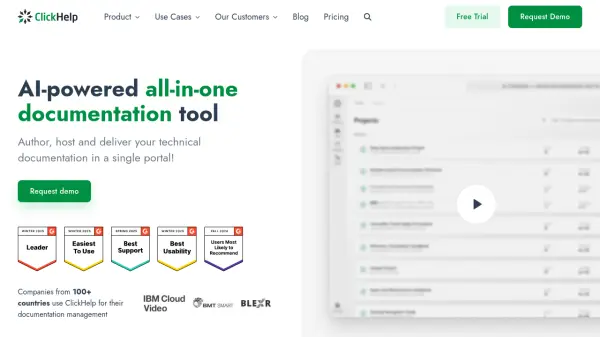What is DeveloperHub?
DeveloperHub provides a comprehensive platform designed for the collaborative creation and management of online documentation. It caters to various team members, offering both WYSIWYG and docs-as-code editing options, eliminating the need for technical skills for content contribution. The platform streamlines the publishing workflow, removing complexities associated with managing plugins, software updates, or deployment processes, allowing teams to focus solely on content quality.
This solution integrates user guides and powerful API references seamlessly within a single portal, supporting OpenAPI 2/3 definitions and enabling direct API testing. Built-in analytics and feedback mechanisms help teams understand user needs and improve documentation effectiveness, aiming to reduce support ticket volume. Customization options allow businesses to align the documentation portal with their brand identity, including logos, colours, fonts, custom CSS/JS, and dark theme support.
Features
- Collaborative Editor: Supports WYSIWYG and docs-as-code (Markdown) with features like image/video embedding, multi-tab code blocks, glossary, templates, and content reuse.
- API Documentation: Create, edit, and publish API references from OpenAPI 2/3 definitions with a three-column layout and 'Try API Out' functionality.
- AI-Powered Tools: Includes AI natural language search for readers, AI writing assistance for creators, and AI feedback spam detection.
- Publishing Workflow: Features drafts, reviews, commenting, instant publishing, edit history, and version control.
- Customization: Allows branding with logos, colours, fonts, custom CSS/JS, custom landing pages/footers, and a dark theme option.
- Analytics and Feedback: Provides built-in search analytics, reader feedback controls (like/dislike), and integration with Google Analytics.
- Versioning: Manage different versions of documentation and API references corresponding to product releases.
- Access Control: Options for public documentation or private documentation with password protection or email invites.
Use Cases
- Creating and hosting product user guides.
- Building comprehensive API documentation portals.
- Developing internal knowledge bases.
- Managing release notes and FAQs alongside core documentation.
- Collaborating across technical writing, development, and product teams on documentation.
- Analyzing documentation usage and reader feedback to improve content.
FAQs
-
What counts as a project?
A project is a documentation site with its set of settings, customisations and collaborators. One project can have many versions and each version has many documentation and references. You can have unlimited pages in a project. A project has its data siloed, and a project can either be public or private. -
What counts as a version?
A version is a container for documentation and API Reference sections. As your product progresses, you'll be having v2.0, v3.0 and so on. With DeveloperHub you can clone a version with one click and start working on newer version of the product, while keeping the old versions available for customers who are still on older versions. You do not have to version your documentation at all. -
What counts as a documentation section?
A documentation is a set of pages (unlimited). Each project has versions (v1.0, v2.0...). Each version has documentation (Android SDK, iOS SDK,...) and references (REST API). You could have multiple documentation for different products, to explain more complex subjects separately, or for localisation. You can also use multiple documentation for Release Notes, Frequently Asked Questions, and other kinds of guides. -
Who is an editor?
An editor is a collaborator on the project. They could be an admin, publisher, writer or reviewer of all published and unpublished documentation. The project owner is the first editor. The number of readers is not limited. -
What happens when I change between paid plans?
You will instantly get access to that plan's features, and you will be charged a prorated amount based on the percentage of the billing cycle left at the time you changed plans. The impact is carried to the next invoice.
Related Queries
Helpful for people in the following professions
DeveloperHub Uptime Monitor
Average Uptime
100%
Average Response Time
574.13 ms
Featured Tools
Join Our Newsletter
Stay updated with the latest AI tools, news, and offers by subscribing to our weekly newsletter.












